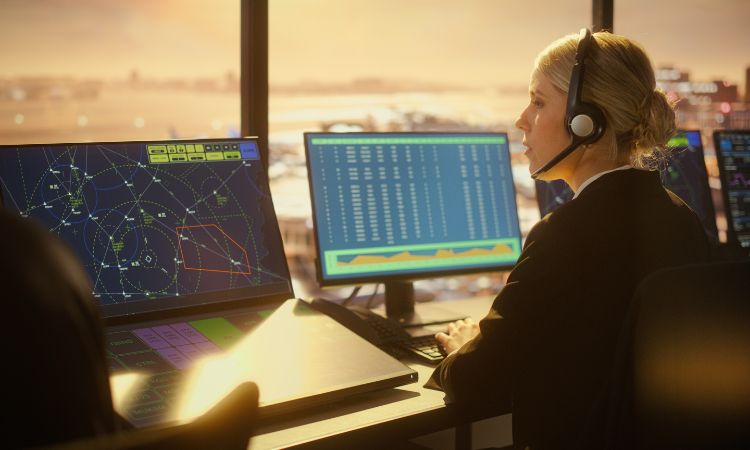Key Technologies Shaping the Future of Air Traffic Control Market

The global air traffic control (ATC) market size reached a value of about USD 10.24 billion in 2023. The industry is further expected to grow at a CAGR of 5.60% in the forecast period of 2024-2032 to reach a value of around USD 16.72 billion by 2032. This exponential growth is a testament to the increasing demand for air travel worldwide. With more aircraft taking to the skies every day, the need for efficient and advanced ATC systems has never been more pressing. In this blog post, we delve into the intricate world of air traffic control and explore the key technologies driving its evolution.
Automation and AI in ATC
One of the most significant advancements in air traffic control is the integration of automation and artificial intelligence (AI). These technologies have revolutionized the way air traffic is managed, offering unprecedented levels of efficiency and safety. Traditional ATC systems relied heavily on manual processes, leaving room for human error. However, with automation and AI, many routine tasks can now be performed autonomously, reducing the workload on air traffic controllers and minimizing the risk of errors.
For instance, AI algorithms can analyze vast amounts of data from various sources, including radar, weather reports, and flight plans, to predict potential conflicts and suggest optimal routes for aircraft. These predictive capabilities enable controllers to proactively manage air traffic and mitigate potential hazards before they escalate. Furthermore, automation allows for seamless coordination between different sectors of airspace, facilitating smoother transitions for aircraft as they traverse through controlled airspace.
Next-Gen Communication Systems
Communication lies at the heart of air traffic control, facilitating the exchange of vital information between aircraft and controllers. Traditional radio communications, while effective, have limitations in terms of range and reliability. To overcome these challenges, next-generation communication systems have emerged, offering enhanced capabilities and reliability.
Data link communication is one such technology that is rapidly gaining traction in the ATC industry. Unlike traditional voice-based communication, data link communication allows for the transmission of digital data between aircraft and controllers. This enables more efficient and precise communication, reducing the risk of miscommunication or misunderstanding.
Another key technology is Automatic Dependent Surveillance-Broadcast (ADS-B), which uses satellite navigation to provide real-time aircraft positioning information. By broadcasting their GPS coordinates, aircraft equipped with ADS-B can be tracked more accurately by ATC systems, leading to improved situational awareness and more effective traffic management.
Satellite-Based Navigation
Navigation is another critical aspect of air traffic control, ensuring that aircraft can navigate safely and efficiently through the airspace. Traditional navigation systems relied on ground-based beacons and radio signals, which had limitations in terms of coverage and accuracy. However, with the advent of satellite-based navigation systems such as the Global Positioning System (GPS) and Galileo, aircraft can now determine their precise position anywhere in the world with unparalleled accuracy.
These satellite-based navigation systems rely on a network of satellites orbiting the Earth, which transmit signals that are received and processed by onboard receivers in aircraft. This enables pilots to navigate more accurately, even in remote or oceanic regions where ground-based navigation aids are scarce. Furthermore, satellite-based navigation systems are not susceptible to line-of-sight limitations, making them ideal for use in mountainous terrain or urban environments where traditional navigation systems may be obstructed.
Cybersecurity in ATC
With the increasing digitization of ATC systems, cybersecurity has emerged as a critical concern. ATC systems are inherently vulnerable to cyber threats, ranging from unauthorized access to malicious attacks aimed at disrupting operations or compromising safety. As such, robust cybersecurity measures are essential to safeguarding the integrity and reliability of ATC systems.
One of the primary challenges in ATC cybersecurity is ensuring the confidentiality, integrity, and availability of sensitive information. This requires implementing encryption protocols to secure communications between aircraft and controllers, as well as authentication mechanisms to verify the identity of authorized users. Additionally, intrusion detection systems are employed to monitor network traffic and identify any suspicious or unauthorized activity.
Environmental and Sustainability Technologies
In recent years, there has been a growing emphasis on sustainability in aviation, driven by concerns over climate change and environmental degradation. As one of the largest contributors to greenhouse gas emissions, the aviation industry is under increasing pressure to adopt more sustainable practices, including in air traffic control.
Continuous Descent Approaches (CDAs) are one such technology that aims to reduce fuel consumption and emissions during the descent phase of flight. Instead of the traditional step-down approach, where aircraft descend in a series of level segments interspersed with periods of level flight, CDAs allow aircraft to descend continuously, minimizing the need for engine thrust and reducing fuel burn.
Similarly, green routing technologies leverage advanced flight planning algorithms to optimize flight paths based on factors such as wind patterns, air traffic congestion, and fuel efficiency. By selecting the most fuel-efficient routes, airlines can reduce their carbon footprint and operating costs while maintaining the highest levels of safety and efficiency.
Click here to checkout our other reports:- https://www.expertmarketresearch.com.au/
ALSO READ:-
Synergies of Business and Technology: Exploring the Future of Innovation











